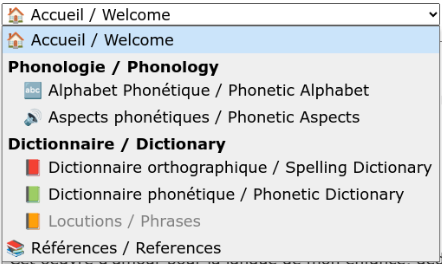(You will find the code below in this TiddlyWiki’s “Home” tiddler.)
\define ⬥m(i v d) <option value="$v$" $d$>$i$ $v$</option>
\define 🔷dropDownMenu()
<$select tiddler="$:/temp/SelectedTiddler" field="text" default={{Accueil / Welcome!!title}}>
<$macrocall $name="⬥m" i=🏠 v={{Accueil / Welcome!!title}}/>
<optgroup label='Phonologie / Phonology'>
<$macrocall $name="⬥m" i=🔤 v={{Alphabet Phonétique / Phonetic Alphabet!!title}}/>
<$macrocall $name="⬥m" i=🔊 v={{Aspects phonétiques / Phonetic Aspects!!title}}/>
</optgroup>
<optgroup label='Dictionnaire / Dictionary'>
<$macrocall $name="⬥m" i=📕 v={{Dictionnaire orthographique / Spelling Dictionary!!title}}/>
<$macrocall $name="⬥m" i=📗 v={{Dictionnaire phonétique / Phonetic Dictionary!!title}}/>
<$macrocall $name="⬥m" i=📙 v={{Locutions / Phrases!!title}} d=disabled/>
</optgroup>
<$macrocall $name="⬥m" i=📚 v={{Références / References!!title}}/>
</$select>
\end
About all of those {{...!! }}: It usually takes me many incremental/iterative tweaks, over long stretches of time, before I’m satisfied with a tiddler title. I depend heavily on the Relink plugin to alter every reference to a tiddler when I do change a tiddler’s title, and {{...!! }} is a no fuss no muss way of making sure Relink does its magic.
And: Using an emoji in a macro name just makes it easier to visually spot calls to that macro.

